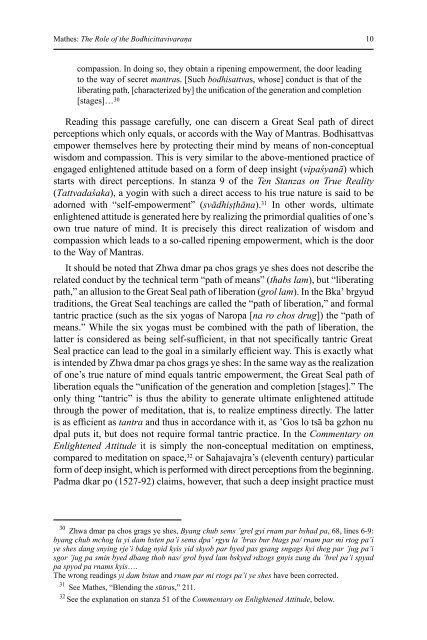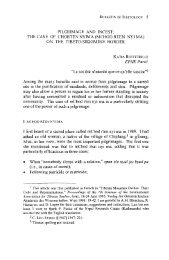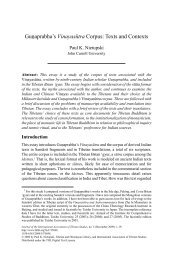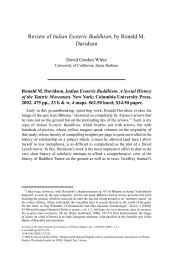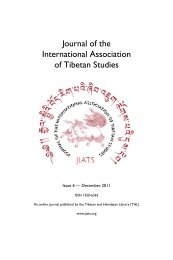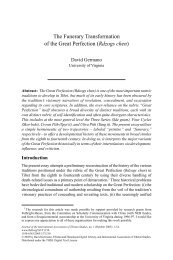The Role of the Bodhicittavivaraṇa in the Mahāmudrā Tradition of ...
The Role of the Bodhicittavivaraṇa in the Mahāmudrā Tradition of ...
The Role of the Bodhicittavivaraṇa in the Mahāmudrā Tradition of ...
You also want an ePaper? Increase the reach of your titles
YUMPU automatically turns print PDFs into web optimized ePapers that Google loves.
Ma<strong>the</strong>s: <strong>The</strong> <strong>Role</strong> <strong>of</strong> <strong>the</strong> <strong>Bodhicittavivaraṇa</strong><br />
compassion. In do<strong>in</strong>g so, <strong>the</strong>y obta<strong>in</strong> a ripen<strong>in</strong>g empowerment, <strong>the</strong> door lead<strong>in</strong>g<br />
to <strong>the</strong> way <strong>of</strong> secret mantras. [Such bodhisattvas, whose] conduct is that <strong>of</strong> <strong>the</strong><br />
liberat<strong>in</strong>g path, [characterized by] <strong>the</strong> unification <strong>of</strong> <strong>the</strong> generation and completion<br />
[stages]… 30<br />
Read<strong>in</strong>g this passage carefully, one can discern a Great Seal path <strong>of</strong> direct<br />
perceptions which only equals, or accords with <strong>the</strong> Way <strong>of</strong> Mantras. Bodhisattvas<br />
empower <strong>the</strong>mselves here by protect<strong>in</strong>g <strong>the</strong>ir m<strong>in</strong>d by means <strong>of</strong> non-conceptual<br />
wisdom and compassion. This is very similar to <strong>the</strong> above-mentioned practice <strong>of</strong><br />
engaged enlightened attitude based on a form <strong>of</strong> deep <strong>in</strong>sight (vipaśyanā) which<br />
starts with direct perceptions. In stanza 9 <strong>of</strong> <strong>the</strong> Ten Stanzas on True Reality<br />
(Tattvadaśaka), a yog<strong>in</strong> with such a direct access to his true nature is said to be<br />
adorned with “self-empowerment” (svādhiṣṭhāna). 31 In o<strong>the</strong>r words, ultimate<br />
enlightened attitude is generated here by realiz<strong>in</strong>g <strong>the</strong> primordial qualities <strong>of</strong> one’s<br />
own true nature <strong>of</strong> m<strong>in</strong>d. It is precisely this direct realization <strong>of</strong> wisdom and<br />
compassion which leads to a so-called ripen<strong>in</strong>g empowerment, which is <strong>the</strong> door<br />
to <strong>the</strong> Way <strong>of</strong> Mantras.<br />
It should be noted that Zhwa dmar pa chos grags ye shes does not describe <strong>the</strong><br />
related conduct by <strong>the</strong> technical term “path <strong>of</strong> means” (thabs lam), but “liberat<strong>in</strong>g<br />
path,” an allusion to <strong>the</strong> Great Seal path <strong>of</strong> liberation (grol lam). In <strong>the</strong> Bka’ brgyud<br />
traditions, <strong>the</strong> Great Seal teach<strong>in</strong>gs are called <strong>the</strong> “path <strong>of</strong> liberation,” and formal<br />
tantric practice (such as <strong>the</strong> six yogas <strong>of</strong> Naropa [na ro chos drug]) <strong>the</strong> “path <strong>of</strong><br />
means.” While <strong>the</strong> six yogas must be comb<strong>in</strong>ed with <strong>the</strong> path <strong>of</strong> liberation, <strong>the</strong><br />
latter is considered as be<strong>in</strong>g self-sufficient, <strong>in</strong> that not specifically tantric Great<br />
Seal practice can lead to <strong>the</strong> goal <strong>in</strong> a similarly efficient way. This is exactly what<br />
is <strong>in</strong>tended by Zhwa dmar pa chos grags ye shes: In <strong>the</strong> same way as <strong>the</strong> realization<br />
<strong>of</strong> one’s true nature <strong>of</strong> m<strong>in</strong>d equals tantric empowerment, <strong>the</strong> Great Seal path <strong>of</strong><br />
liberation equals <strong>the</strong> “unification <strong>of</strong> <strong>the</strong> generation and completion [stages].” <strong>The</strong><br />
only th<strong>in</strong>g “tantric” is thus <strong>the</strong> ability to generate ultimate enlightened attitude<br />
through <strong>the</strong> power <strong>of</strong> meditation, that is, to realize empt<strong>in</strong>ess directly. <strong>The</strong> latter<br />
is as efficient as tantra and thus <strong>in</strong> accordance with it, as ’Gos lo tsā ba gzhon nu<br />
dpal puts it, but does not require formal tantric practice. In <strong>the</strong> Commentary on<br />
Enlightened Attitude it is simply <strong>the</strong> non-conceptual meditation on empt<strong>in</strong>ess,<br />
compared to meditation on space, 32 or Sahajavajra’s (eleventh century) particular<br />
form <strong>of</strong> deep <strong>in</strong>sight, which is performed with direct perceptions from <strong>the</strong> beg<strong>in</strong>n<strong>in</strong>g.<br />
Padma dkar po (1527-92) claims, however, that such a deep <strong>in</strong>sight practice must<br />
30<br />
Zhwa dmar pa chos grags ye shes, Byang chub sems ’grel gyi rnam par bshad pa, 68, l<strong>in</strong>es 6-9:<br />
byang chub mchog la yi dam bsten pa’i sems dpa’ rgyu la ’bras bur btags pa/ rnam par mi rtog pa’i<br />
ye shes dang sny<strong>in</strong>g rje’i bdag nyid kyis yid skyob par byed pas gsang sngags kyi <strong>the</strong>g par ’jug pa’i<br />
sgor ’jug pa sm<strong>in</strong> byed dbang thob nas/ grol byed lam bskyed rdzogs gnyis zung du ’brel pa’i spyad<br />
pa spyod pa rnams kyis….<br />
-<br />
<strong>The</strong> wrong read<strong>in</strong>gs yi dam bstan and rnam par mi rtogs pa’i ye shes have been corrected.<br />
31<br />
See Ma<strong>the</strong>s, “Blend<strong>in</strong>g <strong>the</strong> sūtras,” 211.<br />
32 See <strong>the</strong> explanation on stanza 51 <strong>of</strong> <strong>the</strong> Commentary on Enlightened Attitude, below.<br />
10


